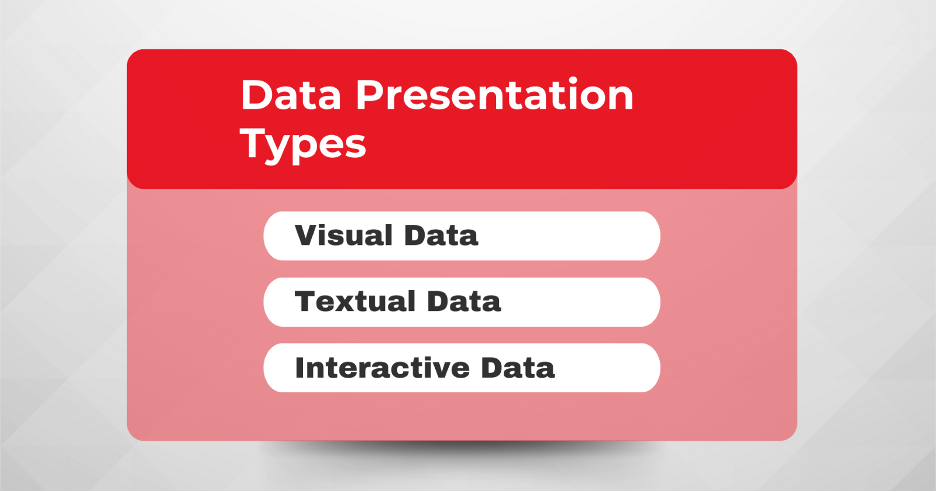Data presentation is the process of structuring, visualizing, and communicating data to an audience. It involves converting raw numbers and figures into meaningful insights that can be easily understood and used to inform decisions. Data can be displayed in formats ranging from simple tables and charts to sophisticated interactive models and dashboards.
Businesses and organizations rely on data to guide their strategies and decisions. However, raw data, in its unprocessed form, can be difficult to interpret. A well-constructed presentation can highlight trends, correlations, and even forecasts that may otherwise go unseen. It transforms data into actionable insights, making it a critical component of decision-making processes.
This article will cover the various types of data presentation, principles for effective communication, common mistakes to avoid, and the tools available for making data presentation more impactful.
Data Presentation Types
Data can be presented in many different formats, each serving a specific purpose depending on the nature of the information and the audience. To better understand what data presentation is, one should first learn the three data presentation types.
You may also like: Maximizing the Value of Cloud Analytics and Big Data

Visual Data Presentation
Visual data presentation is one of the most commonly used forms and involves using charts, graphs, and infographics. This approach is especially useful when dealing with large datasets or complex relationships that are better understood through visualization.
Types of visuals include:
- Bar charts for comparing quantities.
- Line graphs to show trends over time.
- Pie charts to illustrate proportions.
- Infographics to combine visuals and narrative for storytelling.
Visual data presentation is highly effective because it capitalizes on our natural ability to process images faster than text. It is ideal for presenting data to a broad audience, such as stakeholders or customers who may not be familiar with the technical aspects of the data.
Textual Data Presentation
While visual data helps to simplify complex ideas, textual data presentation (like reports, tables, and narratives) offers the depth and explanation often needed for more detailed understanding. Textual data is crucial for:
- Reports that provide context, analysis, and interpretation.
- Tables that offer precise numerical data and comparisons.
- Narratives that explain trends, causality, and projections.
This method of presentation is especially useful in scenarios where accuracy, detail, and interpretation are paramount, such as in technical reports or research documents.
Interactive Data Presentation
Interactive data presentation, such as dashboards and visualization tools, allows users to explore the data on their own terms. These formats offer dynamic, customizable views, enabling users to filter and drill down into specific data points based on their needs. Dashboards can incorporate both visual and textual data sets, providing a comprehensive overview of the information.
Tools such as dashboards in Power BI or Tableau offer an overview of KPIs in real time. Additionally, interactive graphs in D3.js, Plotly, or Power BI let users hover over data points for more details.
This type of presentation is powerful in environments where ongoing analysis is required, providing insights that can adapt to changing data.
Principles of Effective Data Presentation
Regardless of the type of presentation, there are universal principles that govern effective data communication. These principles ensure that data not only looks good but also serves its intended purpose.
Clarity
The data must be clear and easy to understand. Overcomplicating visuals with excessive elements or unclear labeling can confuse the audience. Always aim for simplicity and focus on the key message you want to communicate.
Relevance
The data presented should be tailored to the audience and the decisions they need to make. Presenting too much irrelevant data can dilute the key insights and cause decision paralysis. Always ask: Does this data contribute to the decision at hand?
Accuracy
Accuracy is paramount. Misrepresenting data, whether intentional or accidental, can lead to faulty conclusions and decisions. Always ensure your data sources are reliable, and your calculations are correct.
It is equally important to ensure that your audience accurately understands the information being presented. Even if the data itself is accurate, misinterpretation by the audience can lead to incorrect conclusions. For example, displaying "All Sales" when the data only includes "Invoiced Sales" can mislead viewers. Be clear and precise in your labeling and explanations to avoid confusion.
Accessibility
Consider the accessibility of the data for different members of the audience. This includes presenting data in a format that is understandable to both technical and non-technical stakeholders, as well as accounting for physical accessibility. For example, consider colorblind users when choosing color palettes for charts.
5 Common Mistakes in Data Presentation
Even with the right intentions, it’s easy to fall into common pitfalls when presenting data. Being aware of these mistakes can help avoid miscommunication and ensure that the data speaks for itself.
1. Overcomplicating Visuals
It can be tempting to use fancy graphics or an overwhelming number of data points in a single chart. However, too much complexity can hinder comprehension. Simplicity is key; a clean, well-labeled chart will always outperform a cluttered one.
2. Misleading Charts
Misleading charts can distort the truth by manipulating scale or proportions. For example, starting a bar chart at a non-zero baseline can exaggerate differences between data points. Always ensure that the visual representation aligns with the true data.
3. Biases in Data
Bias in the underlying data is a frequent issue that often gets overlooked in the presentation process. One famous example is the apparent correlation between ice cream sales and murder rates in Chicago. These trends have more to do with the rise in temperature than with a direct cause-effect relationship. Data presenters must recognize and mitigate bias in the data to avoid misleading conclusions.
4. Forgetting Accessibility
When data presentation overlooks the needs of the audience, the insights can become useless. For example, creating a report with colors that are indistinguishable to colorblind users can result in key information being lost. Always test your visuals for accessibility.
5. Choice of Chart Type
Selecting the wrong type of chart can obscure the data rather than highlight it. For instance, a pie chart is not ideal for showing trends over time, while a line graph might fail to clearly convey proportions. The choice of chart type should align with the key message you are trying to convey.
Data Presentation Tools
To assist in the creation of effective data presentations, a variety of tools are available. Each data presentation tool offers different levels of sophistication depending on the needs of the user.
Spreadsheet Software
Tools like Excel and Google Sheets remain staples for simple data analysis and presentation. With basic charting options and table formats, these platforms are ideal for creating straightforward presentations.
Business Intelligence Software
Power BI and Tableau are excellent for more advanced data presentations, offering dynamic dashboards and in-depth visualizations that can handle large datasets. These tools also allow for real-time updates, making them ideal for tracking KPIs and performance metrics.
Advanced Data Visualization Software
For custom visualizations, platforms like D3.js, Plotly, or Power BI provide highly flexible options. These data presentation tools require more technical skills but allow for the creation of unique, interactive visualizations.
Dashboarding Software
Looker and Grafana specialize in real-time, dynamic dashboards that offer businesses an ongoing view of their data. These data presentation tools are especially useful for monitoring live metrics and responding to trends as they happen.
Conclusion
Effective data presentation is an essential skill for any business that wants to make informed, data-driven decisions. By understanding the different types of data presentation, adhering to core principles, and avoiding common mistakes, businesses can ensure that their data delivers maximum impact. However, leveraging the right tools is just as important and further enhances the ability to communicate insights clearly and effectively.
Emergent Software Can Help
As a seasoned software development company, we understand the value of clear, actionable data. Our clients can expect us to not only develop top-tier solutions but also ensure that data presentation is seamless and impactful throughout our partnership.
Schedule a free consultation today and let us help you turn your data into actionable insights.
FAQ
Here are some commonly asked questions about data presentation. They should help clarify the topic further.
What is data presentation?
Data presentation is the process of organizing and displaying data in a structured format to communicate insights effectively, often using visuals, text, or interactive methods.
What are the three data presentation types?
The three data presentation types are visual data presentation, textual data presentation, and interactive data presentation.
What are the 5 ways of presenting data?
Five common ways of presenting data are:
- Bar charts for comparing quantities
- Line graphs to show trends over time
- Pie charts for displaying proportions
- Tables for precise numerical data
- Dashboards for interactive and real-time data analysis
What is the best tool for data presentation?
The best data presentation tool depends on the complexity of the data and the audience. For simple data, Excel or Google Sheets are effective, while more advanced needs are best served by tools like Power BI or Tableau for dynamic, visual presentations.






